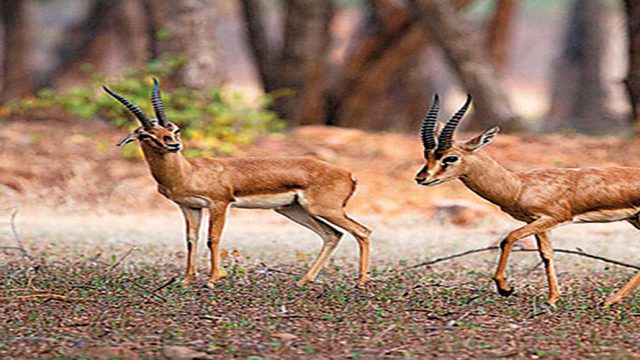With the demand for wildlife tourism increasing across the country, Telangana too has much to offer within its share of dry deciduous forests. The state has has seven wildlife sanctuaries, three national parks and two tiger reserves. As much as 25.19 per cent of the state’s geographical area is covered in forests. The reserves, sanctuaries and national parks cover almost 5 per cent of the area here. Telangana is part of the Deccan Plateau Geographical zone. The plateau’s topography primarily comprises dense and thorny jungles, interspersed with huge rocky outcrops and grasslands. Several rivers as well as natural and man-made water bodies sustain life in these forests. This habitat shelters many endangered herbivores such as the black buck, chinkara, chowsingha, etc. as well as a variety of birds – green bee-eater, hoopoe, drongo, ibis, kingfisher and Indian roller (the state bird of Telangana).

Not far from the state capital of Hyderabad, the Mrugavani National Park, spread over an area of 3.5sq km, is home to about 600 species of flora and fauna, including the wild boar, fox and even Indian vipers. The Mahavir Harina National Park in Hyderabad is the largest green lung space in the city. Although famous as a deer park, it also has a wide variety of avian life.
Wildlife enthusiasts can also head to the Kinnerasani Wildlife Sanctuary, which has a deer park where one can see spotted deer. Located near the town of Palvancha, this sanctuary is also home to the tiger, leopard, chinkara, hyena, jackal and gaur. Reptiles such as the marsh crocodile and monitor lizard can also be found here, owing to the splendid Kinnerasani reservoir, which is located in the central area of the forest. Another feature of Kinnerasani are the natural springs, called Togus. The Kawal Tiger Reserve, located in Adilabad District, is also worth visiting. Tiger, leopard, Indian fox, Indian wild dog and chowsingha are some of the animal species that can be spotted here. Nature lovers won’t be disappointed because of the Kuntala and Pochera waterfalls, which are located in close proximity to this reserve.


The Amradbad Tiger Reserve, spread over the districts of Mahbubnagar and Nalgonda, has the largest population of tigers in the state. Spread over an area of 2,166sq km and located adjacent to the Krishna river, the reserve is also home to various reptiles, about 200 species of birds and a few endangered medicinal plants. The forest department conducts a wildlife safari here to the Farahabad Tiger View Point.
The Eturnagaram Wildlife Sanctuary in Warangal District is one of the oldest sanctuaries in the state. The Godavari river cuts through this reserve, making it rich in flora and fauna. One can spot the tiger, leopard, wolf, sloth bear and nilgai amongst others here. The sanctuary contains many reptile species such as the python, cobra and the mugger crocodile. Freshwater crocodiles can also be seen in the Manjira, Pranahita and Shivaram wildlife sanctuaries.

Most of Telangana’s wildlife parks are easily accessible, but have still not been overrun by tourists, making them ideal destinations for nature lovers. However, for various reasons, sightings are extremely rare. In some forests, there is a lot of human disturbance, while in others, tourists are not allowed in the core area of the sanctuary where there is a higher concentration of wildlife.
In most places, there are no trained guides who can help you spot pug marks, scat and other such telltale signs of the presence of wildlife. Nevertheless, you may come across a variety of birds, snakes, butterflies and the occasional deer or wild boar, but do not expect much more. There have been no reported sightings of tigers in the past few years, although there are about 20 big cats in the state.
Considering the immense human pressure on the forests, tourists should attempt to reduce their ecological footprint. Do not smoke or litter the parks and carry all the non-biodegradable waste back with you to the nearest city, where it can be properly disposed off. On spotting wildlife, do not go too close to them or try to feed them. Whenever in doubt, follow the instructions of the forest rangers and officers.
Some parks also have state-run accommodation facilities as well as private hotels and resorts. Ideal seasons to visit are November to March, when the jungle is green and the weather pleasant. Many of these wildlife parks have beautiful meadows, pristine lakes and a sizeable deer population, making them good picnic spots for families.




